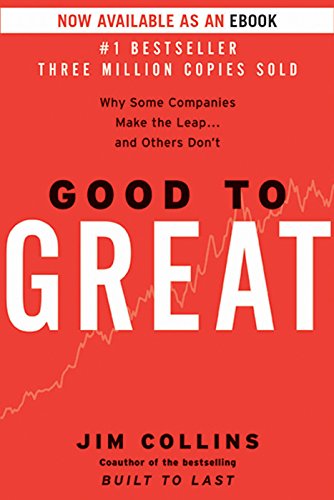

This article is an excerpt from the Shortform summary of "Good to Great" by Jim Collins. Shortform has the world's best summaries of books you should be reading.
Like this article? Sign up for a free trial here .
In his book Good to Great, Jim Collins argues that good is the enemy of great. Why? And must we all strive for greatness? What separates the good companies from the truly great ones?
We’ll cover why good is the enemy of great and Jim Collins’s strategies for turning a good company into a great one.
Must We All Strive for Greatness?
Before the transition point, both the good-to-great companies and their comparisons were either tracking or slightly bettering the general market return. But this didn’t feel enough.
Why try to build something great?
Collins has two answers:
#1: Greatness requires no more (and sometimes less) effort than goodness.
Although fewer companies reach greatness overall, the actual procedures necessary to achieve greatness—hiring the right people, developing a Hedgehog Concept, maintaining discipline—aren’t prohibitively painful.
Think about the “stop doing” list: Many of the reforms necessary to achieve greatness actually involve reducing energy output and waste.
If you’re wasting time on tasks that aren’t priorities, you may have a good company, but not a great one. This is one reason good is the enemy of great.
#2: If you feel like what you do has purpose, the quest for greatness is a given.
The Level 5 executives Collins interviewed strived for greatness not for accolades or material rewards but rather for the sake of greatness itself.
They believed deeply in their mission and the mission of their companies, and because they felt like what they did had profound meaning, they wanted to do it as best they could. It would never occur to them to settle for “just OK.” If you settle for good, you’ll never be great. Good is the enemy of great.
If, at your job or in another area of your life, you find yourself content to float in the middle of the pack, it stands to reason that that part of your life doesn’t excite your imagination and passion. Remember hedgehog thinking: Greatness requires great enthusiasm. If you’re doing something you love, you can’t help but want to be great at it.
And once you start doing meaningful work, you will find yourself on the path to having a meaningful life and feeling like you made a contribution. Collins ends the book on a reflective note, saying that the greatest satisfaction is knowing that your short time alive meant something.
Good Is the Enemy of Great
The follow-up to Built to Last, Jim Collins’s influential study of 18 of America’s enduringly great companies, Good to Great leverages a 20-person research team, dozens of interviews, and thousands of pages of documents to answer two questions: Can a good company become a great one? And, if it can, how? He concluded that a good company can become a great one, but good is the enemy of great. You need to actively work toward greatness to achieve it. Settling for good and waiting for your fortunes to change is never enough.
Methods
To identify clear examples of good-to-great transitions, Collins and his team searched for companies with 15-year returns equal to or below the general market that, after a distinct transition point, recorded 15-year returns at least three times the general market. They found 11 companies that met these criteria.
Collins and his team then identified a “comparison company” for each good-to-great company. The criteria for comparison companies were that (1) they were similarly resourced and situated as their relative good-to-great companies and (2) their returns remained at or below the general market return after the transition point.
The researchers also examined six “unsustained comparisons”—companies that beat the market after the transition point but failed to sustain those results across the full 15-year threshold. These companies settled, and good is the enemy of great.
The Companies
The 11 companies are listed below. Comparison companies are in parentheses, followed by the companies’ industries.
- Abbott (Upjohn) – Health Care
- Circuit City (Silo) – Retail
- Fannie Mae (Great Western) – Financial Services
- Gillette (Warner-Lambert) – Consumer Goods
- Kroger (A&P) – Retail
- Nucor (Bethlehem Steel) – Steel
- Philip Morris (R. J. Reynolds) – Tobacco
- Pitney Bowes (Addressograph) – Business Services
- Walgreens (Eckerd) – Retail
- Wells Fargo (Bank of America) – Banking/Financial Services
Unsustained comparisons:
- Burroughs – Business Services
- Chrysler – Automotive
- Harris – Aerospace and Defense (previously Business Services)
- Hasbro – Toys/Entertainment
- Rubbermaid – Manufacturing
- Teledyne – Conglomerate (Electronics, Aerospace and Defense)
What Distinguished the Great Companies from the Good Ones?
The great companies followed six essential steps. They never settled for good, knowing that good is the enemy of great. The six steps:
1. Cultivating Singular Leadership
Good-to-great companies have what Collins et al. call “Level 5” leaders. Level 5 leaders are personally humble, almost shy, but highly driven professionally—more like Lincoln than Patton.
They avoid the limelight and tend to credit exterior forces or colleagues for their companies’ successes. Although they’re often personally likable and inspiring, they’re not usually “charismatic.”
Their lack of ego enables them to concentrate on one thing and one thing only: the company’s success.
How to achieve it: Collins admits that Level 5 characteristics are likely a product of both nature and nurture and so are difficult to create out of whole cloth; he also doesn’t have hard data to back up any suggestions he might make. His best advice for aspiring Level 5 leaders is to follow the other precepts he outlines. That way, even if you aren’t a Level 5 leader, you’ll at least be acting like one.
2. Assembling the Right Team
Good-to-great companies retain the right people before embarking on any specific program. Good-enough people won’t cut it. (Remember, good is the enemy of great!)
A good-to-great team is composed of people who care deeply about the company and will argue passionately for the decisions they believe are right (but will come together to support whatever decision is eventually reached).
Avoid at all costs the “genius with a thousand helpers” model; management teams should be composed of independent and critical thinkers, not “yes people.”
How to achieve it: (1) Don’t hire until you’re sure you have the right person; (2) recognize when you need to make a change (whether by shifting a role or letting someone go) and act swiftly; and (3) assign your best people to your biggest opportunities rather than your biggest problems.
3. Unearthing and Facing Facts
Good-to-great companies are evangelical about recognizing market realities and reacting in kind.
That said, no matter how dire the facts, they never lose faith that, eventually, they’ll prevail.
The key is to be stoic yet hopeful, realistic without turning cynical.
How to achieve it: With the right management team—one comprising sharp, critical thinkers—the facts should never be in short supply. Leaders can encourage truth-telling by: (1) Beginning meetings with questions, not answers; (2) cultivating, rather than stifling, debate among the team; and (3) conducting clear-eyed analyses of mistakes without assignation of blame.
4. Thinking Like a Hedgehog
“Foxes” know many things and see the world in all its complexity, whereas “Hedgehogs” know one big thing and order the world according to that thing.
A good-to-great company thinks like a hedgehog by developing a “Hedgehog Concept”—an elegant, easy-to-understand guiding philosophy based on facts—that it adheres to fanatically.
How to achieve it: A company’s “Hedgehog Concept” is derived from the answer(s) to three questions: (1) At what can I be the best in the world? (2) What is my financial engine? And (3) What am I profoundly passionate about?
5. Maintaining Discipline
Good-to-great companies make the jump because they constantly refer to and consistently realize their Hedgehog Concepts. Rigorous adherence to a Hedgehog Concept saves companies from panic acquisitions or misguided projects. Some acquisitions will be good, but won’t move the company forward towards its goal, because good is the enemy of great.
Good-to-great companies also lack the administrative and managerial burdens of other companies—with the right people in place and an easy-to-understand Hedgehog Concept, the need for tight management or layers of bureaucracy withers away. Discipline does not mean a tyranny presided over by the executive.
How to achieve it: (1) Allow individuals freedom within a clear framework of responsibility; (2) retain self-disciplined people who are driven to produce results; (3) recognize that a disciplined culture is different from a culture led by a tyrant or disciplinarian; and (4) adhere fanatically to hedgehog thinking. A key technique for staying true to your Hedgehog Concept? Create a “stop doing” list.
6. Using Technology Tactically
For good-to-great companies, technology isn’t the creator of great results but their accelerant.
Rather than follow technological fads and adopt new technology for its own sake, good-to-great companies pioneer particular uses of new technology.
How to achieve it: When evaluating a new technology, the key question to ask is: How does this technology impact my Hedgehog Concept? If it doesn’t, you can safely ignore it and/or accept parity in its use; if it does, you must figure out how you can lead in the application of that technology.
Flywheels vs. Doom Loops
Each step on the road to great takes time—there is no bolt from the blue or miracle moment. But patience doesn’t mean settling for good and denying that good is the enemy of great. It means aiming high but knowing it will take time to get there.
Collins likens the process of going from good to great to the turning of a heavy flywheel. To get the flywheel moving takes continuous effort and dedication, but once it’s spinning, its momentum keeps it going. Greatness is the result of the steady, disciplined adherence to the six steps described above.
Unfortunately, many leaders are under the impression that massive success can happen overnight—by dint of a splashy initiative, big-ticket acquisition, or cutting-edge technology. These moves all too often fail and lead to further drastic measures—restructurings, layoffs—which lead to further declines and on and on. This painful cycle is the “doom loop,” and it can be avoided by the diligent observance of Collins’s six steps.
———End of Preview———

Like what you just read? Read the rest of the world's best summary of "Good to Great" at Shortform . Learn the book's critical concepts in 20 minutes or less .
Here's what you'll find in our full Good to Great summary :
- The 3 key attributes of Great companies
- Why it's better to focus on your one core strength than get spread thin
- How to build a virtuous cycle, or flywheel effect, in your business





